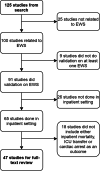Early warning score validation methodologies and performance metrics: a systematic review
- PMID: 32552702
- PMCID: PMC7301346
- DOI: 10.1186/s12911-020-01144-8
Early warning score validation methodologies and performance metrics: a systematic review
Erratum in
-
Correction: Early warning score validation methodologies and performance metrics: a systematic review.BMC Med Inform Decis Mak. 2025 Jan 6;25(1):4. doi: 10.1186/s12911-024-02795-7. BMC Med Inform Decis Mak. 2025. PMID: 39762899 Free PMC article. No abstract available.
Abstract
Background: Early warning scores (EWS) have been developed as clinical prognostication tools to identify acutely deteriorating patients. In the past few years, there has been a proliferation of studies that describe the development and validation of novel machine learning-based EWS. Systematic reviews of published studies which focus on evaluating performance of both well-established and novel EWS have shown conflicting conclusions. A possible reason is the heterogeneity in validation methods applied. In this review, we aim to examine the methodologies and metrics used in studies which perform EWS validation.
Methods: A systematic review of all eligible studies from the MEDLINE database and other sources, was performed. Studies were eligible if they performed validation on at least one EWS and reported associations between EWS scores and inpatient mortality, intensive care unit (ICU) transfers, or cardiac arrest (CA) of adults. Two reviewers independently did a full-text review and performed data abstraction by using standardized data-worksheet based on the TRIPOD (Transparent reporting of a multivariable prediction model for individual prognosis or diagnosis) checklist. Meta-analysis was not performed due to heterogeneity.
Results: The key differences in validation methodologies identified were (1) validation dataset used, (2) outcomes of interest, (3) case definition, time of EWS use and aggregation methods, and (4) handling of missing values. In terms of case definition, among the 48 eligible studies, 34 used the patient episode case definition while 12 used the observation set case definition, and 2 did the validation using both case definitions. Of those that used the patient episode case definition, 18 studies validated the EWS at a single point of time, mostly using the first recorded observation. The review also found more than 10 different performance metrics reported among the studies.
Conclusions: Methodologies and performance metrics used in studies performing validation on EWS were heterogeneous hence making it difficult to interpret and compare EWS performance. Standardizing EWS validation methodology and reporting can potentially address this issue.
Keywords: Early warning score; Methodology; Validation.
Conflict of interest statement
The authors declare that they have no conflict of interest. The authors would like to highlight that they included a paper they wrote in this review.
Figures
References
-
- DeVita MA, Hillman K. Why RRS? Where RRS? Crit Care Clin. 2018 Apr;34(2):xi–xii. - PubMed
-
- Alam N, Hobbelink EL, van Tienhoven AJ, van de Ven PM, Jansma EP, Nanayakkara PW. The impact of the use of the Early Warning Score (EWS) on patient outcomes: a systematic review. Resuscitation. 2014;85(5):587–94. 10.1016/j.resuscitation.2014.01.013. - PubMed
-
- Douw G, Huisman-de Waal G, van Zanten AR, van der Hoeven JG, Schoonhoven L. Nurses' 'worry' as predictor of deteriorating surgical ward patients: A prospective cohort study of the Dutch-Early-Nurse-Worry-Indicator-Score. Int J Nurs Stud. 2016;59:134–40. 10.1016/j.ijnurstu.2016.04.006. - PubMed
-
- Morgan RJM, Williams F, Wright MM. An early warning scoring system for detecting developing critical illness. Clin Intensive Care. 1997;8:100.
-
- National Institute for Health and Clinical Excellence. Acute ill patients in hospital: recognition of and response to acute illness in adults in hospital. In: NICE clinical guideline No. 50. London; 2007. - PubMed
Publication types
MeSH terms
LinkOut - more resources
Full Text Sources
Other Literature Sources
Medical
Miscellaneous




